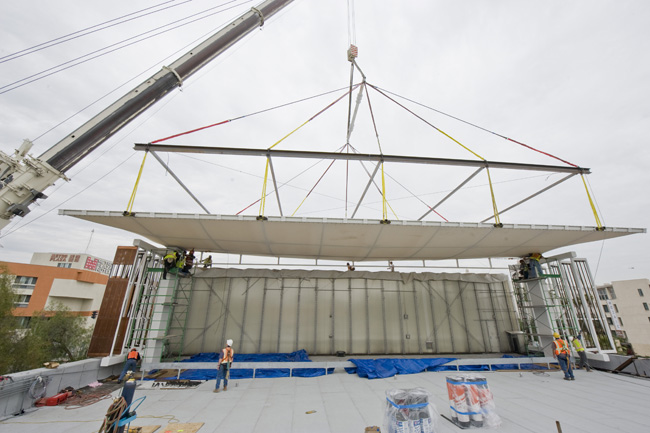
A canopy to protect the mural América Tropical, weighing 73,000 pounds and boasting an impressive 90-foot span, is lifted aloft by a construction crane and set into place.
Construction for the shelter, viewing platform, and interpretive center that will surround América Tropical, the only surviving public mural by David Alfaro Siqueiros in the United States still in its original location, is moving forward. The mural, located on the second-story wall of the Italian Hall on Olvera Street in the El Pueblo historical Monument, has been covered for nearly its whole life. A joint project by the City of Los Angeles and the Getty Conservation Institute, with funding from the Getty Foundation, is working to bring the mural back to public view after almost 80 years.
The project had a very visible presence in the sky above Main and Olvera Streets Tuesday as the canopy to protect the mural, weighing 73,000 pounds and boasting an impressive 90-foot span, was lifted aloft by a construction crane and, after some tough work, set gently into place. The massive steel-framed canopy structure is covered in a high-tech white fabric often used to cover stadiums, a combination of fiberglass and polytetrafluoroethylene (better known as Teflon) that stands up to the elements and gives it an otherworldly appearance.
Construction crews worked all day on Monday to set up two massive cranes and a specially built metal frame to support the canopy and prevent it from torquing while in the air. Given the size of the canopy and frame, the construction foreman told me that the crane first required enough ballast to stabilize the crane and counterbalance the canopy—about 300,000 pounds of ballast, in fact.

A workman carefully maneuvers the canopy to protect the mural América Tropical.
On Tuesday morning, after checking and rechecking their calculations, the construction crew gave a cheer as the massive structure lifted into the air and swung there for a moment. Gusts of wind threatened to postpone the lift, but the crew was finally able to get the canopy up, past the trees and lightposts, turning and swinging it over the top of the viewing platform and rooftops, then lowering it onto two massive poles sunk deep into the ground to support it.
Standing on the viewing platform and watching the canopy sway overhead was an amazing experience—several onlookers likened it to a beautiful spaceship.
The white structure was carefully aligned, which took some time, and then finally bolted into place. Crews still have a few days of work ahead, securing and welding the canopy and working out other final details. Given the complicated planning and maneuvers required to turn, lift, and secure the canopy, it was a great feat of engineering that it all went so smoothly.

The canopy to protect the mural América Tropical, nearly installed.
It’s also an exciting turning point in the América Tropical project, an ongoing public-private partnership between the City of Los Angeles and the Getty, and Tuesday’s efforts gave excitement about the project a big lift as well! The canopy is now visible from Olvera and Main Streets and highlights the recent progress of the project to provide the public with access to Siqueiros’s mural, which is slated to go back on view this fall, 80 years after it was first unveiled by the artist. One of the great Mexican muralists of the 20th century, Siqueiros painted América Tropical in 1932 on the second story exterior wall of the Italian Hall.
The mural depicts a Mexican Indian tied to a double cross with an American eagle above him as revolutionary soldiers—one aiming at the eagle—close in. Controversial from the start, within a few months the mural was partially whitewashed, and within a decade completely covered. The work was virtually forgotten until the 1960s, when the rise of the Chicano mural movement brought a renewed interest in América Tropical. We’ll update you on The Iris as the project moves toward its final unveiling this fall.

The canopy to protect the mural América Tropical, after installation.
The construction consists of the new protective shelter spanning the south wall of the Italian Hall—including the canopy as well as sun shades on each side to protect the mural from direct exposure to sun and rain. A rooftop platform also has been constructed across from the mural to allow public viewing access. In the next month or so, the installation of the roll down screen that will protect America Tropical from direct sunlight, rain, and other damage, will be installed. The screen will have an image of the mural printed on it, so that even when the screen is lowered at 4:00 p.m. daily to prevent it from fading in the sunlight that hits the mural wall, it will still have a visible presence.
Due to the early whitewashing and ongoing exposure to the elements, the mural has deteriorated and its colors have become faint. The GCI already has carried out extensive research, documentation, and conservation treatment, including plaster stabilization, cleaning, and consolidation on the work. GCI scientists also have conducted scientific studies to identify the materials used by Siqueiros to create the mural. Additional conservation work by the GCI team will take place over the summer, with the goal to honor and protect that which remains from Siqueiros’s own hand, not to restore (or repaint) the work.
Following the completion of the project, the GCI has committed to maintaining and conserving the mural for the next decade. The long-term stewardship of the mural will rest with the City of Los Angeles.
Architectural firm Brooks + Scarpa is overseeing the design and construction of the shelter, platform, and an interpretive center to help the public learn more about Siqueiros and his artwork for the city of Los Angeles’s Bureau of Engineering.




Comments on this post are now closed.